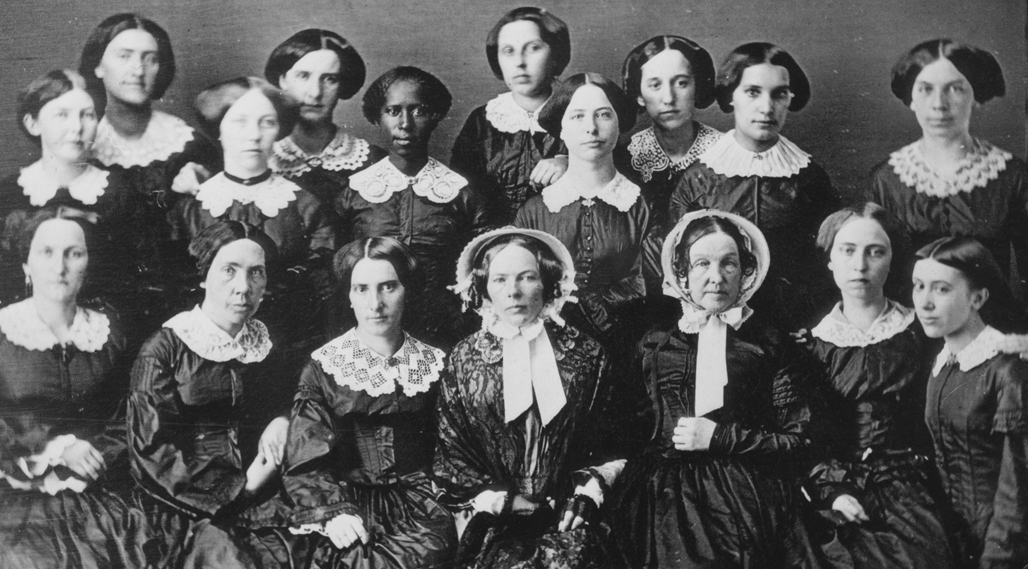"The Necessity Of A Pure Heart"
The Oberlin Female Reform Society, 1835-1857

Graduates of 1855, including Marianne Parker Dascomb, front row center
Collection:
Oberlin Female Moral Reform Society, RG 31/6/11
Authors:
Adrian Bennett, Kitt Disston, Sophie Hess
TRANSCRIPTIONS
- Document 1: Oberlin Female Moral Reform Society Constitution & Preamble, 1835
- Document 2: Oberlin Female Moral Reform Society Meeting Minutes, June 1840-August 1840
- Document 3: Oberlin Female Moral Reform Society Annual Report, 1840
- Document 4: Oberlin Female Moral Reform Society Meeting Minutes, 22 June 1841-12 May 1842
INTRODUCTION
The Oberlin Female Moral Reform Society, founded in 1835, was one of the largest in the nation. With 380 members by 1840, the Society worked to promote the interests, improve the wellbeing, and expand the agency of women in their town.1 While many of the concerns addressed by female reformers centered on what they called "licentiousness," a broad term used to describe a range of sexual aggressions and improprieties committed against women, the Society also created a unique space in which its members could speak openly about the changing role of women in society.
Archival records of the Oberlin Female Reform Society exist solely in the form of the organization's minute book, which covers the period from 1835 to 1857. Although many prominent Oberlin women held leadership roles within the Society, the notes in the minute book do not reflect one dominant voice. Rather, the entries report a broad range of activities and opinions, including the Society's annual meetings, presentations of visiting speakers, and the reading of moral reform papers. This variety in reporting provides a composite summary of the organization's goals and strategies. Thus, as a primary source, the minute book provides valuable insight into how Oberlin's female reformers utilized the era's politics of respectability to assert their agency.
Chaired by and composed of influential local women, including Lydia Andrews Finney, Alice Welch Cowles, and Marianne Parker Dascomb, the Oberlin society, like others across the United States, worked towards multifaceted goals. One of the Female Moral Reform Society's main objectives was to prevent immorality through educational efforts and adherence to strict moral codes of conduct. They questioned the blame heaped upon women for their abuses at the hands of immoral men and promoted the idea that female virtues, like modesty and restraint, should act as moral benchmarks for men as well as women. As Lori Ginzberg explains in her article about early Oberlin, "[The Female Moral Reform Society] sought to abolish this double standard not by having women act like men, but by demanding of men the same standards of virtue and passionlessness that society expected of women."2
The idea that traditionally feminine behaviors and values could be influential, rather than inherently inferior to their masculine counterparts, had been articulated before, nearly a century earlier, in Mary Wollstonecraft's A Vindication or the Rights of Women (1792). Rather than raising one sex above the other, Wollstonecraft wrote: "The two sexes mutually corrupt and improve each other."3 Although it is unlikely that Wollstonecraft's Vindication directly influenced Oberlin's "insistence on applying female virtues to community life," female moral reformers in Oberlin dovetailed and expanded upon this rhetoric by asserting that men could, and should, learn from women's morality and personal constraint.4
Other female moral reform societies across the country shared this attitude; however they saw women largely as reform placeholders until "the husbands and fathers and sons [...] come up to this work with the noble spirit they evince in other labors of Christian philanthropy."5 What set the Oberlin Female Moral Reform Society apart was its prioritization of female leadership and autonomy coupled with its emphasis on the role of women as archetypes of moral virtue. The platform of the Oberlin society represents a broader tactic of women's organizations and thinkers during the antebellum era. By advocating for women's rights while simultaneously maintaining a framework of Christian morality and respectability, women were able to critically address injustices without being chastised for transgressing normative gender expectations.
[2] Lori D. Ginzberg, "The 'Joint Education of the Sexes': Oberlin's Original Vision," in Educating Men and Women Together, ed. Carol Lasser, (Urbana: University of Illinois Press, 1987), 72.
[3] Mary Wollstonecraft, A Vindication of the Rights of Women (London, W. Scott, 1892, originally published 1792).
[4] Ginzberg, 69.
[5] Female Moral Reform Society of the City of New York, Report at the First Annual Meeting of the New York Female Moral Reform Society, May 15, 1835 (New York: William Newell, 1835), as reproduced in Carol Lasser and Stacey Robinson, Antebellum Women (Lanham: Rowman and Littlefield Publishers, 2010), 134-135.